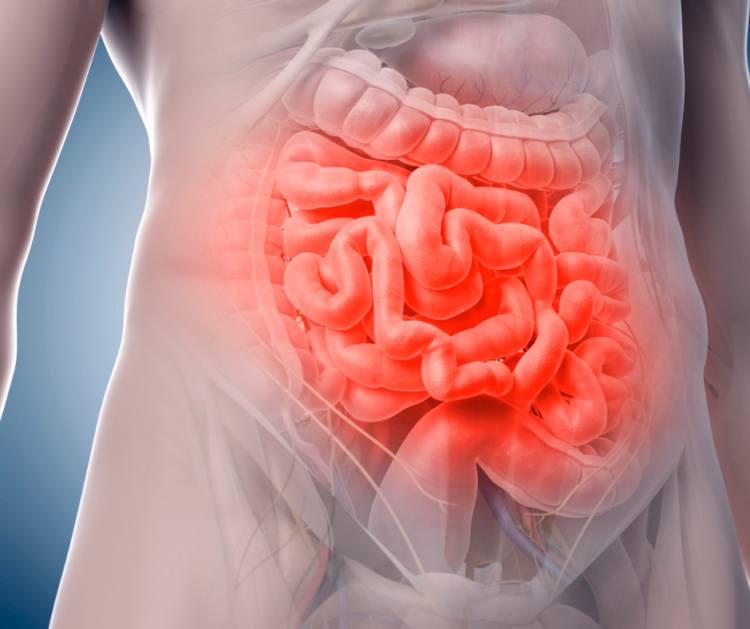Table of Contents
Ileocecal Valve Syndrome (ICVS)
A few years back I did some training in Neuro Emotional Technique. One of the lessons during the weekend was on the Ileocecal Valve Syndrome also called the great mimicker as this syndrome is often overlooked in the medical profession. I was surprised to learn how many symptoms were associated with the ileocecal valve (ICV) challenge so thought you all would like to know about it too.
The ileocecal valve, (pronounced ill-e-o-see-cal), is a one-way valve (when healthy) that separates the small intestine from the large intestine preventing backflow of the large intestinal contents into the small intestine. The valve is located in the lower right quadrant just above the front of the hip bone. The ileocecal valve is also known as Bauhin’s valve, Ileocolic valve, McBurney’s Point and Valvula coli.
Normally the ileocecal valve will be closed/relaxed and opens when a bolus of food passes from the small intestine into the large intestine (your inner sewer pipe) during peristalsis (the normal rhythmic movement of the gut) but when the valve spasms or stays open (90% of the ICV sufferers), your inner sewer pipes back up disturbing normal digestion and allowing unhealthy toxins to be absorbed by the body. Over time, this can be quite significant to the health of the body and often manifests as horrible bad breath. Sometimes the valve stays closed and won’t open (10% of ICV sufferers) which can cause additional challenges (listed below under symptoms).
Open ileocecal valve sufferers experience an increase in parasympathetic nervous system stimulation (their digestive tracts are too relaxed). Chronically open ileocecal valves will lead to dehydration and fluid retention while closed valve ileocecal valve sufferers experience an increased sympathetic nervous system stimulation meaning the system is tense and contracted due to increased adrenal function.
Symptoms Associated with a Dysfunctional Ileocecal Valve Include:
- Allergies
- Constipation (associated with closed valve disease)
- Dark circles under the eyes
- Dizziness (especially mid-afternoon 1-3pm)
- Fainting
- Fibromyalgia
- Flu symptoms
- General achiness
- Halitosis (Bad breath)
- Heart palpitations or fluttering
- Increased body odor
- Indigestion (Gas/Bloating)
- Irritable bowel (diarrhea then constipation)
- Liver disease (with chronic challenge)
- Low back pain
- Migraine headaches
- Nausea
- Pain around the heart during exercise
- Pale face
- Right shoulder pain/bursitis
- Right-sided pelvic pain
- SIBO (Small Intestine Bacterial Overgrowth) https://www.ncbi.nlm.nih.gov/pmc/articles/PMC3099351/
- Sinus infections, recurrent
- Sluggish and weak body or tense and uptight but better with movement/motion of the body (closed valve syndrome sufferers)
- Stiff neck
- Sudden thirst
- Tinnitus
- Weakened Immune System
The Core Causes of Ileocecal Valve Syndrome Involve:
- Abdominal cramping from other diseases affecting the body
- Bacterial or viral infections within the digestive tract
- Decreased digestive enzymes
- Decreased stomach acid (e.g. when Blood Type A people drink too much water with meals or people take antacids)
- Exercise: Too many isometric abdominal exercises
- Neurological disruptions in the abdomen
- Spinal subluxation at the 1st lumbar vertebra or subluxations affecting the pelvic area
- Parasites (protozoal, tapeworms or roundworms)
- Candida (yeast) overgrowth in the gut
- Chemicals affecting the nervous system
- Bloating
- Dietary (see Natural Treatments under Diet)
- Eating too many raw foods containing large amounts of fiber (raw food diets)
- Emotional aspects (deep-seated emotions not being released)
- Flatulence (the pressure within the digestive tract upsets the valves causing spasm)
- Frequent snacking
- Lumbar disc herniation with no apparent trauma
- Overactive sympathetic nervous system issue
- Raw Food Diet advocates (common with Open Valve syndrome)
- Third chakra imbalances
Natural Treatments for Ileocecal Valve Syndrome Include:
-
- Addressing the emotions not released from the body
- Chewing food thoroughly (you should not be seeing pieces of undigested food in the feces)
- Chiropractic adjustments to correct the neurolymphatic and neurovascular reflexes
- Colonics
- Diet: Eliminate nightshades (tomatoes, potatoes, eggplant, peppers, tobacco, gogi berries, tomatillos are some of nightshades) Also, minimizing certain foods such as carbonated drinks, iceberg lettuce, chocolate, hot spicy foods (like salsa, cinnamon, cloves), alcohol, caffeine and excessive raw foods high in fiber
- Eating for your blood type (www.dadamo.com) or using Dr. D’Adamo’s SWAMI program after figuring out your secretor status
- Eating slowly, less frequently, eliminating snacks and not overeating
- Filtering the bathing and drinking water to get the chlorine out which kills the good gut flora and harms the reproductive organs
- Homeopathy: (Note that we’re attempting to treat physical systems so using the lower dilutions even though the C dilution is available in health food stores. It’s best to use the 6X and 30X dilutions. The higher dilutions such as C and M treat the mental/emotional/etheric aspects of the body) Bryonia (Wild Hops) 6X, Iris tenax 6X, 30X and Rhus tox (Poison-ivy) 6x, 30X
- Increasing the hydration of the body by drinking water BETWEEN meals
- Massage in general and especially massage the inner and outer thighs from the knees upwards (self-massage works)
- Pressing the ileocecal valve area with the flat of your hand (all fingers) and maintaining pressure there for 5 mins/day for 4 weeks then continuing this technique once a week for several months
- Visceral Manipulation
Supplements Historically Used for Treatment of ICVS:
- Adrenal herbs
- Betaine HCl
- Calcium for closed valve syndrome
- Chlorophyll for open valve syndrome
- Digestive Enzymes
- Garlic, raw
- Magnesium maleate
- Slippery Elm Bark
- Vitamin B-12
- Vitamin C (Ester C)
Note: Appendicitis also shows up as pain in this area of the body but is associated with a high white blood cell count and fever and quite a bit of pain when the patient raises up on their tippy toes and then comes down with a jarring motion on their heels. This is an emergency and should be treated as such with acute medical care.
Helpful Links and References for Ileocecal Valve Syndrome (ICVS):
- Neuro Emotional Technique: https://www.netmindbody.com/more-information/an-introduction-to-net
- Homeopathy for ileocecal valve syndrome: https://www.dynamicchiropractic.com/mpacms/dc/article.php?id=9074
- Ileocecal valve manipulation: https://www.drdavidwilliams.com/how-to-manipulate-your-ileocecal-valve-for-better-health
Keywords: ileocecal valve, ICV, ICVS, ileocecal valve syndrome, Bauhin’s valve, Ileocolic valve, McBurney’s Point, Valvula coli, lower right abdominal pain

